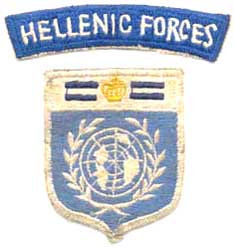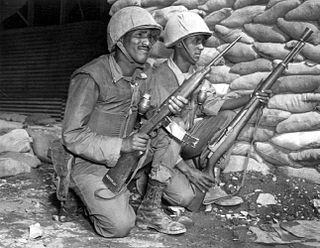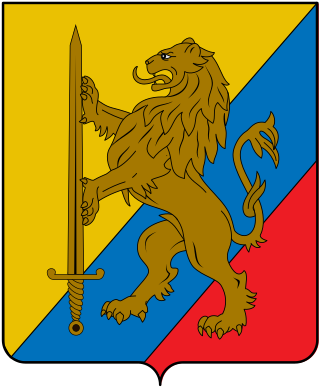Related Research Articles

The Korean War was fought between North Korea and South Korea from 1950 to 1953. It began on 25 June 1950 when North Korea invaded South Korea and ceased after an armistice on 27 July 1953. North Korea was supported by China and the Soviet Union while South Korea was supported by the United States and US-led United Nations (UN) forces.

The Republic of Korea Armed Forces, also known as the ROK Armed Forces, are the armed forces of South Korea. The ROK Armed Forces is one of the largest and most powerful standing armed forces in the world with a reported personnel strength of 3,930,000 in 2024.

The Regiment van Heutsz is a line infantry regiment of the Royal Netherlands Army. The regiment was named after J.B. van Heutsz, a former Governor-General of the Dutch East Indies who successfully brought the Aceh War closer to an end, and was formed on July 1, 1950. It is notable for its service as part of the United Nations force sent to fight during the Korean War. It is still operational and has served tours as part of the ISAF Afghanistan mission.
The Presidential Unit Citation is a military unit award of the government of Republic of Korea that may be presented to South Korean military units and foreign military units for outstanding performance in defense of the Republic of Korea. In recognition of allied military service to South Korea during the Korean War, all United States military departments were authorized the unit award for that period.
The French Battalion of the United Nations Organisation was a battalion of volunteers made up of active and reserve French military personnel sent to the Korean Peninsula as part of the UN force fighting in the Korean War.

The Greek Expeditionary Force (GEF) in Korea was formed in response to the United Nations appeal for assistance in the Korean War. It comprised a reinforced Hellenic Army (HA) infantry battalion and the Royal Hellenic Air Force (RHAF) 13th flight of seven transport planes (C-47). Greece originally intended to send a brigade to Korea; upon consultation with the US, however, the expeditionary force was downgraded to a battalion attached to the US 1st Cavalry Division. The 13th Flight supported the US marine division and played an important role of evacuating the dead and the wounded. After the armistice, the RHAF unit withdrew in May 1955 and the HA unit in December 1955. Greece was the fifth largest troop contributor to U.N. Forces in Korea.

The involvement of New Zealand in the Korean War began in 1950 as a response to the United Nations Security Council's call for combat assistance in the erupting Korean War. New Zealand was one of the first nations to respond with support.

Australia entered the Korean War on 28 September, 1950; following the invasion of South Korea by North Korea. The war's origins began after Japan's defeat in World War II, which heralded the end to 35 years of Japanese occupation of the Korean Peninsula. The surrender of Japan to the Allied forces on 2 September 1945, led to the division of Korea into two countries, which were officially called the Democratic People's Republic of Korea (DPRK) and the Republic of Korea (ROK), with the DPRK being occupied by the Soviet Union, and the ROK, below the 38th Parallel, being occupied by the United States (US).

The Kagnew Battalions were a number of military units from the Imperial Ethiopian Army which fought as part of United Nations Command in the Korean War (1950–53). The battalions rotated yearly, with the First Kagnew Battalion arriving at the front in 1951. The Third Kagnew Battalion which arrived in 1953, stayed through the signing of the armistice into 1954. Over the next two years more Ethiopians guarded the stalemate in Korea as part of the Fourth Kagnew Battalion and the Fifth Kagnew Company. Even though some publications indicate Ethiopians remained in Korea until 1965, in fact they remained a part of the United Nations Command until 1975. Members of Kagnew Battalion were, with few exceptions, drawn from the Ethiopian Imperial Bodyguard Division.

The Philippine Expeditionary Force to Korea (PEFTOK) (Spanish: Fuerza Expedicionaria Filipina a Corea or FEFC, Tagalog: Puwersang Expedisyonarya ng Pilipinas sa Korea or PEPK, Korean: 필리핀 한국 원정군; RR: Pillipin han-guk wonjeonggun) was the Philippine Army contingent of the United Nations forces that fought in the Korean War (1950–1953). The unit arrived in Korea in August 1950. It was composed of 1,468 troops, and was the fifth largest force under the United Nations Command. The PEFTOK took part in the Battle of Miudong (which was hailed as the first battle won by Filipino soldiers in a foreign soil) Battle of Yultong and the Battle of Hill Eerie. The unit operated alongside the United States 1st Cavalry Division, 3rd Infantry Division, 25th Infantry Division, and 45th Infantry Division.

The Turkish Brigade, codenamed North Star, was a military formation from Turkey that served under the United Nations Command during the Korean War.

The First and Second Battles of Wonju, also known as the Wonju Campaign or the Third Phase Campaign Eastern Sector, was a series of engagements between North Korean and United Nations (UN) forces during the Korean War. The battle took place from December 31, 1950, to January 20, 1951, around the South Korean town of Wonju. In coordination with the Chinese capture of Seoul on the western front, the North Korean Korean People's Army (KPA) attempted to capture Wonju in an effort to destabilize the UN defenses along the central and the eastern fronts.

The Volunteer Corps for Korea was a Belgium–Luxembourg military force sent to assist South Korea during the Korean War. A battalion-sized unit, it arrived in Korea in 1951 and remained after the cease-fire until 1955. Over the course of its existence, 3,171 Belgians and 78 Luxembourgers served in the unit.

The Kingdom of Thailand was one of the 21 countries who responded to the United Nations request to send troops to aid South Korea during the Korean War 1950–1953. As well as being one of the first countries to openly express its support for South Korea's cause, whilst also being one of the UN's larger contributors to the war. Thai support was important to battles determining the outcome of the war, such as the Third Battle of Seoul.
The Canadian Forces were involved in the 1950–1953 Korean War and its aftermath. More than 30,000 Canadians participated on the side of the United Nations, and Canada sent eight destroyers. Canadian aircraft provided transport, supply and logistics. 516 Canadians died, 312 of which were from combat. After the war, Canadian troops remained for three years as military observers.

The military history of the United States during the Korean War began after the defeat of Japan by the Allied Powers in World War II. This brought an end to 35 years of Japanese occupation of the Korean peninsula and led to the peninsula being divided into two zones; a northern zone occupied by the Soviet Union and a southern zone occupied by the United States. After negotiations on reunification, the latter became the Republic of Korea or South Korea in August 1948 while the former became the Democratic People's Republic of Korea or North Korea in September 1948.

The United Nations Memorial Cemetery in Korea, located at Tanggok in the Nam District, City of Busan, Republic of Korea, is a burial ground for United Nations Command (UNC) casualties of the Korean War. It contains 2,300 graves and is the only United Nations cemetery in the world. Laid out over 14 hectares, the graves are set out in 22 sites designated by the nationalities of the buried servicemembers.

The Colombian Battalion was an infantry battalion of the Colombian Army that served under United Nations Command during the Korean War from 1951 to 1954. The first Colombian military unit to serve in Asia, the battalion was attached to the U.S. 7th Infantry Division and 25th Infantry Divisions.

In support of the United Nations Command, Luxembourg sent 110 troops to fight in Korea. Of these, 2 died and 17 were injured. Luxembourg decided to ally with the Belgians and form 1st Platoon A Company, and with the Belgians arrived in Korea on 31 January 1951. Many Luxembourgers decided to join the Belgian Volunteer Corps for Korea. Luxembourg would fight at Imjin River, Haktang-ni, and Chatkol. Luxembourg contributed a 44-man rifle regiment called the Royal Luxembourg Regiment. The Luxembourgers left Korea in January 1953
The United Kingdom was involved in the Korean War between 25 June 1950 and 27 July 1953. 56,000 British troops participated on the side of the United Nations force.
References
- ↑ 한국전 참전 16개국 기념 조형물을 찾아서
- ↑ The Statistics of the Korean War – ROK Ministry of National Defense Institute for Military History, 2014 (E-BOOK) Archived 2023-07-09 at the Wayback Machine (in Korean)
- ↑ The Statistics of the Korean War – ROK Ministry of National Defense Institute for Military History, 2014 (PDF) Archived 2021-01-11 at the Wayback Machine (in Korean)
- ↑ "Defense POW/MIA Accounting Agency > Our Missing > Past Conflicts". www.dpaa.mil.
- ↑ The Korean War Veterans Memorial Wall of Remembranc
- ↑ 추모의 벽’ 준공…6·25전사 미군·카투사 4만여명 이름 각인
- ↑ A Korean War Wall of Remembrance Set Hundreds of Errors in Stone
- ↑ 워싱턴 '추모의 벽' 전사자 명단 오류와 관련하여 다음과 같이 설명드립니다
- ↑ Fact Sheet: America's Wars" – U.S. Department of Veteran Affairs
- The History of the UN Forces in the Korean War-1 ( ETHIOPIA, PHILIPPINES, SOUTH AFRICA, THAILAND, TURKEY) – ROK Ministry of National Defense Institute for Military History, 1972 (E-BOOK) Archived 2023-07-09 at the Wayback Machine
- The History of the UN Forces in the Korean War-1 ( ETHIOPIA, PHILIPPINES, SOUTH AFRICA, THAILAND, TURKEY) – ROK Ministry of National Defense Institute for Military History, 1972 (PDF) Archived 2023-06-28 at the Wayback Machine
- The History of the UN Forces in the Korean War-2 (AUSTRALIA, CANADA, INDIA, NEW ZEALAND, UNITED KINGDOM) – ROK Ministry of National Defense Institute for Military History, 1981 (E-BOOK) Archived 2023-07-09 at the Wayback Machine
- The History of the UN Forces in the Korean War-2 (AUSTRALIA, CANADA, INDIA, NEW ZEALAND, UNITED KINGDOM) – ROK Ministry of National Defense Institute for Military History, 1981 (PDF) Archived 2023-06-05 at the Wayback Machine
- The History of the UN Forces in the Korean War-3 (BELGIUM, COLOMBIA, FRANCE, GREECE, LUXEMBOURG, NETHERLANDS, DENMARK, ITALY, NORWAY, SWEDEN) – ROK Ministry of National Defense Institute for Military History, 1974 (E-BOOK) Archived 2023-07-09 at the Wayback Machine
- The History of the UN Forces in the Korean War-3 (BELGIUM, COLOMBIA, FRANCE, GREECE, LUXEMBOURG, NETHERLANDS, DENMARK, ITALY, NORWAY, SWEDEN) – ROK Ministry of National Defense Institute for Military History, 1974 (PDF) Archived 2023-06-05 at the Wayback Machine
- The History of the UN Forces in the Korean War-4 (UNITED STATES) – ROK Ministry of National Defense Institute for Military History, 1975 (E-BOOK)
- The History of the UN Forces in the Korean War-4 (UNITED STATES) – ROK Ministry of National Defense Institute for Military History, 1975 (PDF)
- The History of the UN Forces in the Korean War-5 (UNITED STATES) – ROK Ministry of National Defense Institute for Military History, 1976 (E-BOOK)
- The History of the UN Forces in the Korean War-5 (UNITED STATES) – ROK Ministry of National Defense Institute for Military History, 1976 (PDF)
- The History of the UN Forces in the Korean War-6 (SUMMARY) – ROK Ministry of National Defense Institute for Military History, 1977 (E-BOOK) Archived 2023-07-09 at the Wayback Machine
- The History of the UN Forces in the Korean War-6 (SUMMARY) – ROK Ministry of National Defense Institute for Military History, 1977 (PDF) Archived 2023-06-28 at the Wayback Machine
- The Korean War and the UN Forces – ROK Ministry of National Defense Institute for Military History, 2015 (E-BOOK) Archived 2023-07-09 at the Wayback Machine (in Korean)
- The Korean War and the UN Forces – ROK Ministry of National Defense Institute for Military History, 2015 (PDF) Archived 2023-07-09 at the Wayback Machine (in Korean)
- The Statistics of the Korean War – ROK Ministry of National Defense Institute for Military History, 2014 (E-BOOK) Archived 2023-07-09 at the Wayback Machine (in Korean)
- The Statistics of the Korean War – ROK Ministry of National Defense Institute for Military History, 2014 (PDF) Archived 2021-01-11 at the Wayback Machine (in Korean)
- The History of the UN Forces in the Korean War – ROK Ministry of National Defense Institute for Military History, 1998 (E-BOOK) Archived 2023-07-09 at the Wayback Machine (in Korean)
- The History of the UN Forces in the Korean War – ROK Ministry of National Defense Institute for Military History, 1998 (PDF) Archived 2023-07-09 at the Wayback Machine (in Korean)
- The Summary of the Korean War – ROK Ministry of National Defense Institute for Military History, 1986 (PDF) Archived 2023-07-09 at the Wayback Machine (in Korean)
- The History of the Korean War-10: The UN Forces (AUSTRALIA, BELGIUM, LUXEMBOURG, CANADA, COLOMBIA, ETHIOPIA, FRANCE, GREECE, NETHERLANDS) – ROK Ministry of National Defense Institute for Military History, 1980 (E-BOOK) Archived 2023-06-24 at the Wayback Machine (in Korean)
- The History of the Korean War-10: The UN Forces (AUSTRALIA, BELGIUM, LUXEMBOURG, CANADA, COLOMBIA, ETHIOPIA, FRANCE, GREECE, NETHERLANDS) – ROK Ministry of National Defense Institute for Military History, 1980 (PDF) Archived 2023-06-05 at the Wayback Machine (in Korean)
- The History of the Korean War-11: The UN Forces (NEW ZEALAND, PHILIPPINES, SOUTH AFRICA, THAILAND, TURKEY, UNITED KINGDOM, UNITED STATES, DENMARK, INDIA, ITALY, NORWAY, SWEDEN) – ROK Ministry of National Defense Institute for Military History, 1980 (E-BOOK) Archived 2023-07-07 at the Wayback Machine (in Korean)
- The History of the Korean War-11: The UN Forces (NEW ZEALAND, PHILIPPINES, SOUTH AFRICA, THAILAND, TURKEY, UNITED KINGDOM, UNITED STATES, DENMARK, INDIA, ITALY, NORWAY, SWEDEN) – ROK Ministry of National Defense Institute for Military History, 1980 (PDF) Archived 2023-07-09 at the Wayback Machine (in Korean)
